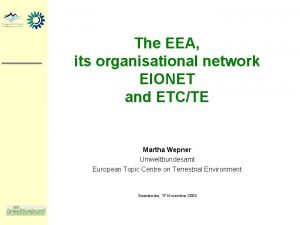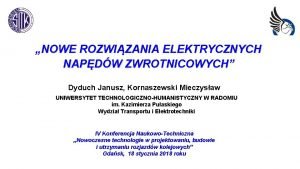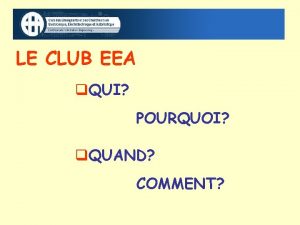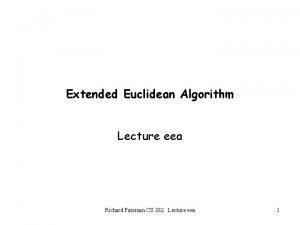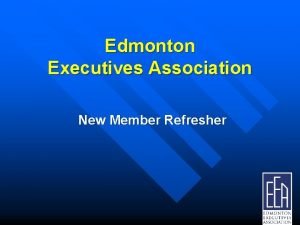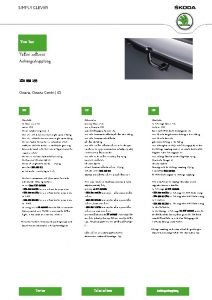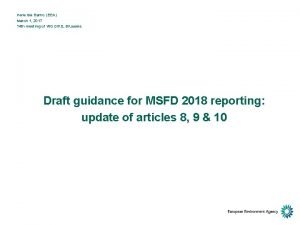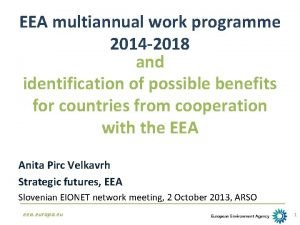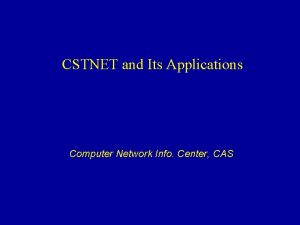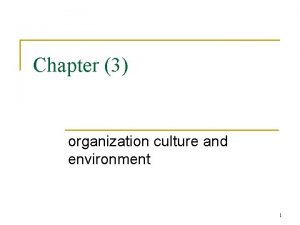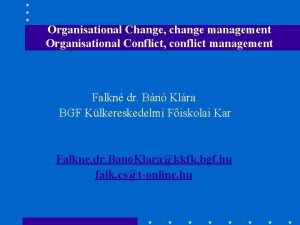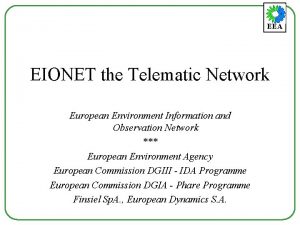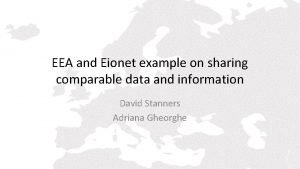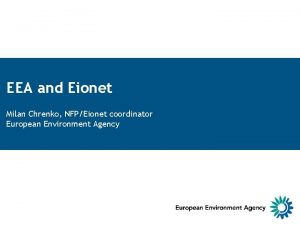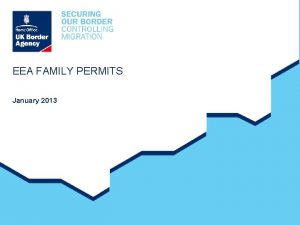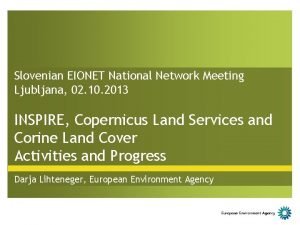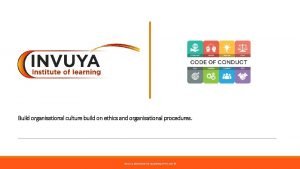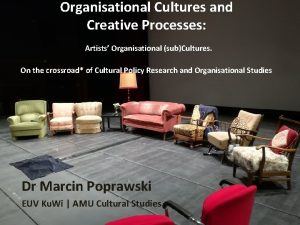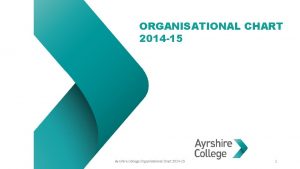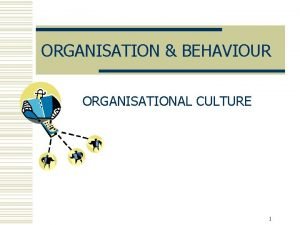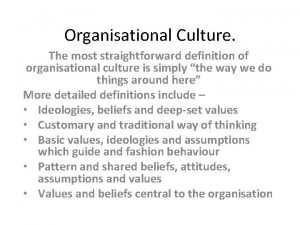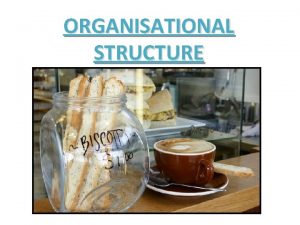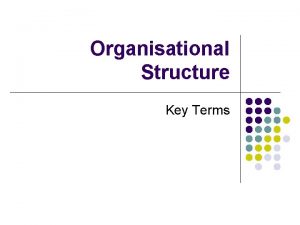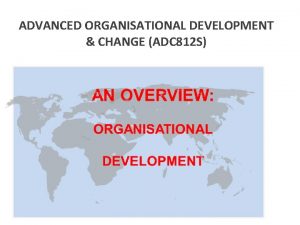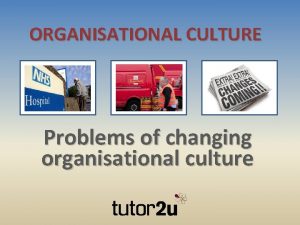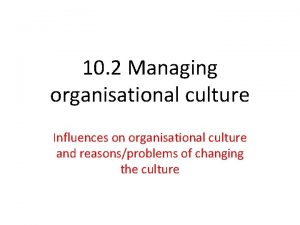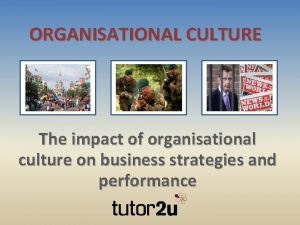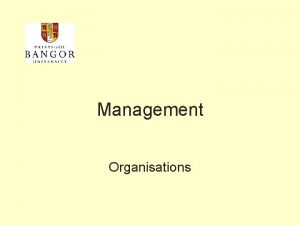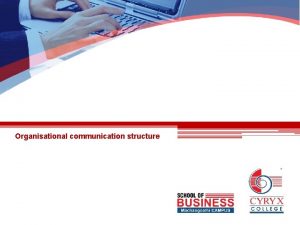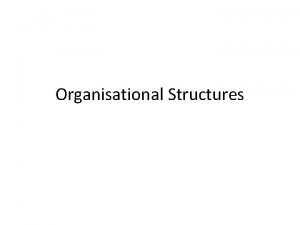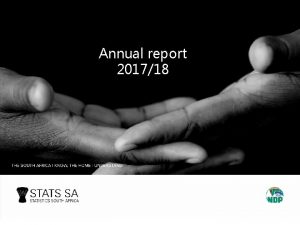The EEA its organisational network EIONET and ETCTE





























- Slides: 29

The EEA, its organisational network EIONET and ETC/TE Martha Wepner Umweltbundesamt European Topic Centre on Terrestrial Environment Szentendre, 17 November 2003

EEA, EIONET, ETC/TE Outline • EEA • Reporting • Networking EIONET What are NFPs/NRCs What are ETCs • ETC/TE and its contribution to the soil work program

EEA European Environment Agency - EEA • one of 11 specialised European Union Agencies • EEC Regulation 1210/1990 • Operational since 1994 • European Reference Centre for environmental information http: //www. eea. eu. int

EEA The EEA mission statement ‘EEA aims to support sustainable development and to help achieve significant and measurable improvement in Europe’s environment, through the provision of timely, targeted, relevant and reliable information to policy making agents and the public. ’

EEA What are the objectives of the mandate? To provide environmental information • Helping the Community and member countries to identify effective environmental measures and assess its actual and expected progress • Maintaining and coordinating the EIONET based on shared information

EEA Who are EEA's clients? • Institution level: European Commission, Parliament, Council, EEA member countries • General public: NGOs, business, media, advisory, groups/persons, debaters and the policy engaged public

EEA

EEA Main tasks • networking • monitoring and reporting Main products • EEA publications • the Agency’s website (www. eea. eu. int)

EEA - reporting EEA Reporting cycle • Broad integrated assessments (Five year state & trends reports, eg. Kiev) • Indicator based reports (yearly Signals Report, TERM report) • Specific issue reports (eg. Greenhouse gases, GMOs) • Best practices (eg. Wastewater treatment report) • Frameworks, guidelines or databases

EEA - networking EEA Networking EEA’s networking partners • EIONET partners in 31 member countries • Co ordinated activities within EC services and programmes • International Organisations UNECE, WHO, OECD and WMO) (UNEP,

EEA - networking EEA Networking

EEA - networking EEA Networking EIONET • European Environment Information and Observation Network • more than 300 national institutions National Focal Point (1 per country) National Reference Centre (various topics) Main Component Elements European Topic Centre (5)

National Focal Points EEA Networking Role of NFPs • Co ordinate Member State input to EEA work programme • Build telematics network in Member State • Co ordinate data flows to ETCs and for EEA reports • Motivate NRCs and MCEs • Appointed by member countries

National Reference Centre EEA Networking Role of NRCs/MCEs • Provide data to ETCs and EEA • Advice on technical aspects to ETC work programme • Comment and review EEA and ETCs reports • Maintain telematics network connection and data flows • Share experience with other NRCs/MCEs

European Topic Centre - ETC Networking Role of ETCs • • • Work under contract to EEA Deliver reports, databases, networks Improve comparability of data Advise on plugging data gaps Support DG Environment on Implementation Represent EEA in various forums

European Topic Centre - ETC Networking Objectives • To provide policy relevant information on past trends, current state and prospective development (of land soil) in Europe • To support legislative frameworks • To support EEA enlargement

European Topic Centre - ETC Networking Structure • Consortia with one leading institution • 5 ETCs ETC/TE ETC/W ETC/ACC ETC/WMF ETC/NPB

ETC/TE European Topic Centre on Terrestrial Environment ETC/TE • Priority areas Soil degradation Land use Urban environment Coastal environment http: //terrestrial. eionet. eu. int

Structure ETC/TE

Background ETC/TE Land Cover Marine and Coastal Environment Soil Terrestrial Environment

Mission ETC/TE • How do we fulfil our mission? – Integrated assessments • DPSIR chain – Environmental indicators • Land cover changes • Soil degradation • Impact on land (e. g. fragmentation) – Support to EU & international policy frameworks (e. g. Soil Thematic Strategy)

Soil issues ETC/TE • Local soil contamination – Contamination from point sources (waste disposal, industrial activities, mining sites, military sites, accidents, etc. ) • Diffuse soil contamination – Contaminants transported over wide areas (including heavy metals, acidification, nutrients surplus – eutrophication, etc. ) • Soil sealing – Covering of soil due to urbanisation, infrastacture construction

Soil issues ETC/TE • Development of soil indicators since 1996 – In course of ETC/S and ETC/TE • EIONET workshops 1999, 2001, 2002, 2003 – Discussions/agreement on indicators and definitions – Data requests – Development of core set of indicators (3 indicators on local soil contamination) – Reporting on soil • EIONET data request 2003 – Local soil contamination – Diffuse soil contamination – Soil sealing http: //eea. eionet. eu. int: 8980/Members/irc/eionet circle/te/library? l=/soil_collection/collection_contamination&vm=detailed&sb=Title

Local soil contamination ETC/TE Local soil contamination • Core Set of Indicators (priority data flow) – Management of contaminated sites – Remediation expenditures – Soil polluting activities (incl. hot spot map) • New indicators (non priority data flow) – Landfills – Mining sites – Remediation activities • New indicators as a result of discussions • Main problem: harmonised data, lack of reporting obligation –> EIONET data request 2003

How much progress is done in the management of contaminated sites? ETC/TE Local soil contamination

What are the major sources of contamination? ETC/TE Local soil contamination

How much is spent for the remediation of contaminated sites? ETC/TE Local soil contamination € per capita and year

How much is spent for the remediation of contaminated sites? ETC/TE Local soil contamination Source: CLC 1990 and ESRI Population Density

Thank you for your attention!
 Eea
Eea Dyduch janusz
Dyduch janusz Club eea
Club eea Eea algorithm
Eea algorithm Edmonton executive association
Edmonton executive association Eea 600 011
Eea 600 011 Irene del barrio
Irene del barrio Eea
Eea Viaggio di ulisse
Viaggio di ulisse They accuse me of being dark in their free city
They accuse me of being dark in their free city Its halloween its halloween the moon is full and bright
Its halloween its halloween the moon is full and bright Nhpce
Nhpce Strong and weak organisational culture
Strong and weak organisational culture Organisational conflict and change
Organisational conflict and change When a train increases its velocity, its momentum
When a train increases its velocity, its momentum Sunny cloudy rainy windy
Sunny cloudy rainy windy If its square its a sonnet summary
If its square its a sonnet summary Its not easy but its worth it
Its not easy but its worth it Virtual circuit and datagram network
Virtual circuit and datagram network Features of peer to peer network and client server network
Features of peer to peer network and client server network Network centric computing
Network centric computing Hình ảnh bộ gõ cơ thể búng tay
Hình ảnh bộ gõ cơ thể búng tay Slidetodoc
Slidetodoc Bổ thể
Bổ thể Tỉ lệ cơ thể trẻ em
Tỉ lệ cơ thể trẻ em Voi kéo gỗ như thế nào
Voi kéo gỗ như thế nào Tư thế worm breton là gì
Tư thế worm breton là gì Hát lên người ơi
Hát lên người ơi Các môn thể thao bắt đầu bằng tiếng nhảy
Các môn thể thao bắt đầu bằng tiếng nhảy Thế nào là hệ số cao nhất
Thế nào là hệ số cao nhất
